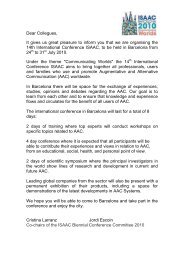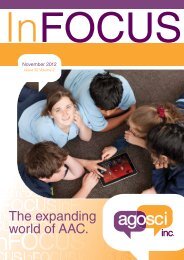22ccommunicationo m m u n i c a t i o nppartnersa r t n e r sCommunicating Respectfully... (cont)Even if a person does not understand a spoken language, theymay still be able to pick up some useful information from voiceinfl ection, intonation, pitch, or accent. Therefore, always usevoice when interacting with a person who is deafblind or hasmultiple disabilities.Hand-Under-HandBarbara Miles’ excellent article Talking the Language of theHands to the Hands (1998) has had a profound effect uponthe thinking of many educators in the field of deafblindness.The strategies proffered have been found to be relevant toindividuals with a range of disabilities, not only people withdeafblindness. Offering our hands, sharing experiences, takingthe lead of the child/adult and acknowledging communicationefforts, are all integral to interacting effectively and developingcommunication in a highly respectful manner. This article ishighly recommended reading.OfferingInteraction, assistance, and communication can occur morerespectfully and effectively by using hand-under-hand, ratherthan manipulating and controlling hands. Hand-under-hand isa concept that is diffi cult for some educators and therapiststo grasp, as shaping and moulding hands has been a longheld trend in working with children with multiple disabilities.However, Deafblind educators have found that the combinationof offering and waiting results in children taking far moreinitiative; individuals also begin to realise that they have thepower to be able to do things for themselves – and the powerto communicate!WaitingThis vital technique cannot be underestimated. Giving achild or adult time, fi rstly to process and then to respond,is essential. Too often we rush, push, prompt, direct, prod,control, manipulate or do something for or to an individual,rather than setting up the environment, providing the stimulusor information and then waiting ………………………giving the person time to process and initiate their response.Sometimes we forget that real learning is about the journeyrather than the destination (e.g., student outcome statementsand progress reports so often rule the day, rather than the timeactually spent interacting and communicating). Somewherealong the line some educators have forgotten that learning isan ongoing process and not a prompted response or a tick ona form! Learning and journeys take time. Waiting is not easy!However, the benefits of waiting for an individual to respondare invaluable!Waiting for an individual’s response is one of the mostimportant elements in fostering the development of effectivecommunication. Deborah Chen’s No Freebies (Chen, 1998)reminds us not to jump in and do things for a child, but toset up the environment to enable and encourage a child tocommunicate what they want or need. Waiting for a responsegives the time needed for a person to process, plan, and thenrespond.Respecting Behaviour as CommunicationAs parents, educators and therapists it is our responsibility toobserve and learn what a child may be trying to tell us, througha particular behaviour or pattern of behaviours.Dr. Tim Hartshorne, highly respected psychologist andauthority on challenging behaviours, has extensive expertisewith children with CHARGE Syndrome 1 . Children withCHARGE have complex sensory and medical conditions,including cranial nerve damage, which could impact upon andinfl uence behaviour. Most children with CHARGE will learnto communicate using formal methods such as speech and/orsign language; however, it is possible that some of the quirkyor challenging behaviours often observed in children withCHARGE Syndrome are another form of communication.“He has no communication…he just screams!” How oftenhave some of us heard that? Renowned deafblind educator,David Brown says, “All behaviour has a purpose.” If a child isscreaming, he is trying to tell us something. By acknowledgingthis behaviour as communication and trying to discover whatthe behaviour may mean, we can then respond in a way whichmay help to modify the screaming into a more desirable form ofcommunication. For example, some children may not yet havelearned another way to communicate, so they scream as theyhave learned that screaming gets attention or what they want.Firstly, always check any possible medical concerns, eg. blisterson feet, constipation, pain, etc, particularly if a behaviour isnew or exacerbated.Imagine: A TAFE 2student, who also happens to be a busaide, came up during a break one day expressing concernover so many of the children on her bus-run, who havecommunication challenges. Apparently, one child neverspoke or made eye contact and didn’t like physical contactof any kind; however, she made repetitive vocalisations. Isuggested that the child’s vocalisations may be her way ofcommunicating something and that it was our job to tryto tap into what those vocalisations might mean, and thesame vocalisations may not always have the same meaningfor that child. As a start, I suggested the bus aide imitatethe girl’s vocalisations…and wait. The very next week this(very excited!) bus aide/student said the child had madeeye contact and smiled for the first time after she imitatedher vocalisations! We then discussed how the bus aidecould again imitate the girl’s vocalisations, always with asmile, and then add the child’s name. The next week, busaide/student rushed into class to say that the child hadresponded to her name by turning to the bus aide and evenreaching out for her!Obviously, the role of a bus aide is not to teach communication!However, this is a great example of how all of us can helpto facilitate and expand communication in every possibleenvironment.Predictable RoutinesEstablishing predictable routines (Axelrod, Condon, Durkel,& Wiley, 1993) is a highly effective way of helping to develop
ccommunicationo m m u n i c a t i o nppartnersa r t n e r sCommunicating Respectfully... (cont)communication through consistency and structure. Routinescan give shape and form to a world that can otherwise be veryfragmented, frustrating, and confusing.There are many ways that everyday routines can provide a basisfor communication.Imagine: Jimmy needs a nappy change…Wherever Jimmy is before his nappy change, he is given anatural touch cue/gesture, for example a pat on his upperthigh near his nappy.Jimmy is then taken into his nappy change area, wherehis nappy is patted again; then, a clean nappy is broughtinto his field of vision, offered near his nose for him tosmell clean nappy and then offered under his hand to feelbefore the old nappy is removed. Once the old nappy isremoved, a cleaning cloth or tissue can be offered underhis hand before wiping his bottom to indicate he is aboutto be wiped. Before the clean nappy goes on, his thighis again patted. This routine gives Jimmy the opportunityto anticipate what is about to happen. Anticipation isan important element of language development. In thissituation the clean nappy is the object symbol. Eventually,the nappy could be reduced in size to an object-symbol ofjust the nappy tab.Calendar boxes or a tangible timetable can be very effectivein giving structure to a day. Depending upon an individual’shearing, vision and communication system, a set of objects,object-symbols, photos, drawings, print or Braille can beused to represent activities throughout the day, presented insequence. Each symbol is taken to the corresponding activity,and then placed into a finished box at the end of the activity. Thisroutine provides clear beginnings and endings to activities.In SummaryThese strategies are simple to learn, easy to implement andmost important of all - respectful.Imagine: “But, we don’t have time to do all this!”Response: Time yourself! Approaching, identifyingyourself and letting a person know where you are goingby providing a touch cue, object symbol, picture or sign,takes approximately 8 seconds!So how can these strategies be effective with individuals whoare not deafblind?It is our responsibility to constantly think of the messages thatwe are, or are not giving to the people entrusted in our care.The strategies offered on these pages can help let children likeCharlie know who we are, where they are going and what ishappening in their world. This is not a huge task; it is simplerespect.1 CHARGE Syndrome is becoming a leading cause of congenitaldeafblindness in developed countries.2 Technical and Further Education; Auslan Studies – DeafblindCommunication modulesImagine: Charlie is not deafblind; he has ‘typical’ hearingand vision. However, Charlie has a severe physical disabilitywhich greatly restricts any voluntary movement; he is in awheelchair for most of his day.Suddenly, without a word, someone pushes Charlie’swheelchair from behind; he doesn’t know who it is becausehe is unable to turn his head to look.“But he knows me!” Does he at that point in time?Remember in a previous section how many adults theremay be in and out of a classroom on any one day? How canCharlie be expected to know who it is at any one point intime, if we don’t give him that information?Charlie is then pushed into an unfamiliar area, and just assuddenly as he was whisked from his room, he is left in astrange environment, staring at a wall…Although Charlie has hearing and vision, he doesn’t knowwho brought him, where he is, or why he is there.ReferencesAxelrod, C., Condon, R., Durkel, J. & Wiley, D. (1993). Ain’tmisbehavin’: Strategies for improving the lives of studentswho are Deafblind and present challenging behavior [Video].Texas: Texas School for Blind and Visually Impaired.Barrey Grassick, S. (1998). CUEmmunication: Beginningcommunication with people who are deafblind, DbI Review,21, 8-9.Brown, D. (2005). “Behaviours”: Challenges or Adaptations?American Journal of Medical Genetics, 133A, 268-272.Chen, D. (1998). Communication strategies. Presentationat Deafblind Winter School, Renwick College, New SouthWales.Hartshorne, T. (2006). The “B” in CHARGE. Paperpresented at 7th Australasian CHARGE Conference,Queensland.Miles, B. (1998). Talking the language of the hands to thehands. DB-Link; The National Information Clearinghouseon Children Who Are Deaf-Blind.Miles, B. & Riggio, M. (Ed.) (1999). Remarkableconversations: A guide to developing meaningfulcommunication with children and young adults who aredeafblind. Massachusetts: Perkins School for Blind.Nafstad, A. & Rodbroe, I. (1999). Co-creatingcommunication. Denmark: Nordic Press, The Nordic StaffTraining Center for Deafblind Services (NUD).23





